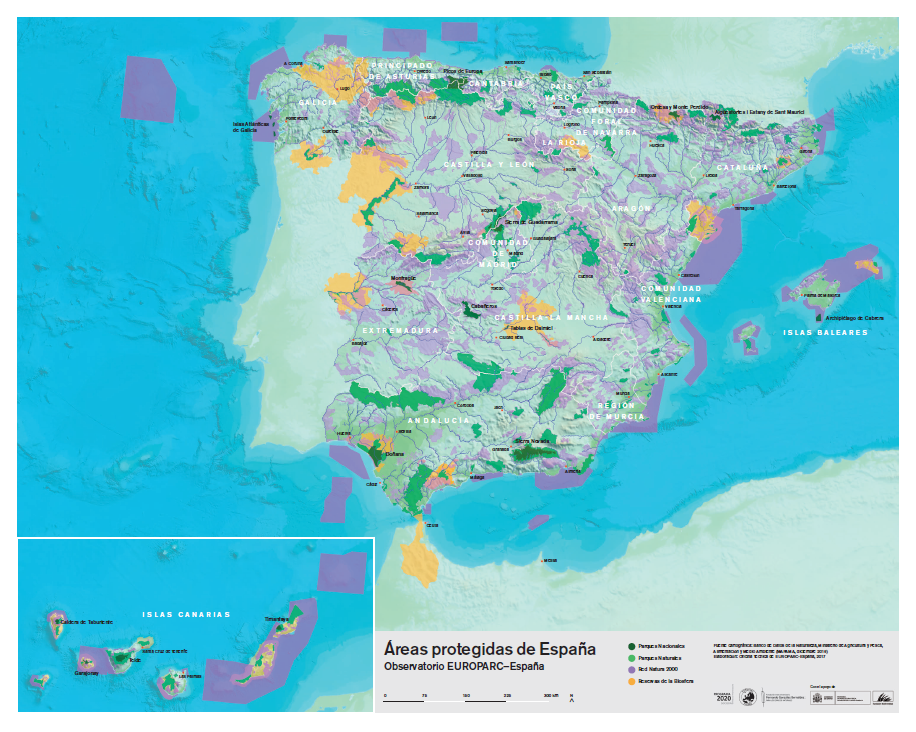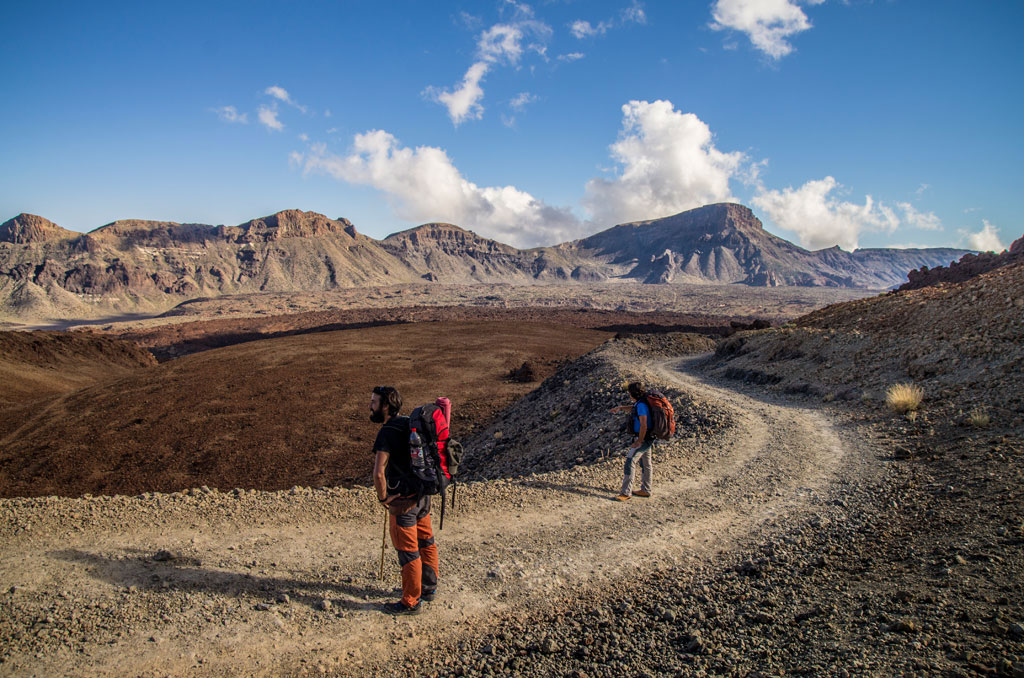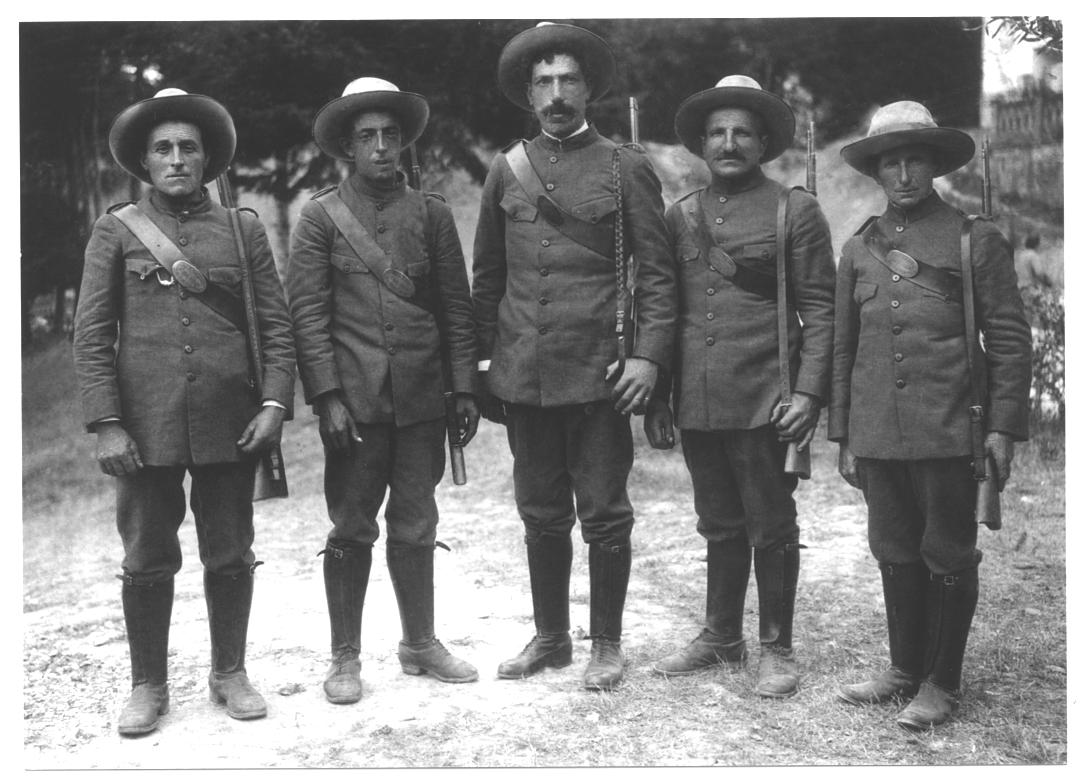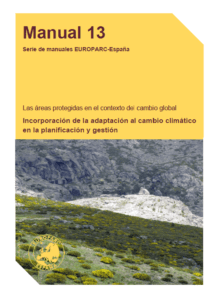La Garrotxa awards Charter Part III to two first tour operators in Spain
Photo: Press conference on Charter Part III awards. From left to right: Beth Cobo – Trescàlia, Eduard Llorà – President of Turisme Garrotxa, Xevi Puig – Director of Parc Natural de la Zona Volcànica de la Garrotxa and Toni Colom – Nit i Vol. Joan Pijuan (CDPNZVG)®
Since EUROPARC French Section developed Charter Part III for the first time in 2014, no other section had gone further in awarding tour operators with the Charter. In January 2017, Parc Natural de la Zona Volcànica de la Garrotxa, in close cooperation with Turisme Garrotxa (ECST Permanent Forum) awarded Nit i Vol and Trescàlia with the ECST Part III, being pioneer in Spain once again: in this case, in implementing agreements with tour
operators.
Charter Part III: Implementation process
The methodology followed by these 2 travel agencies was approved by EUROPARC Federation on October 2015 in Regensburg and basically consists in following steps:
1) Diagnosis of the candidate based on a checklist: candidate must inform on how the travel agency fulfils criteria (checklist system) focused on:
- “Social and labour policy” (training policy in the enterprise, good practices for reconciling work and family life, etc.)
- “Environmental policy” (calculation of carbon footprint, green procurement, carrying capacity consideration when planning visits, relationship with the protected area, etc.)
- “Economic policy” (customer satisfaction surveys, market targeting, etc.).
The key items sum up to 66 but there is no minimum number of criteria that the candidate has to reach -no threshold applies-. Thus, the checklist is just to inform on the starting point and current state of the candidate.
2) Proposal of future actions – commitment: candidate must inform on planned activity to improve its performance in action fields mentioned above: “Social and labour policy”, “Environmental policy” and “Economic policy”. The proposal was approved by the Permanent Forum, Turisme Garrotxa in this case.
3) Submission of the proposal, composed by current diagnosis (check-list on 66 items), action plan and application letter altogether with other formal documents to Charter Part III Evaluation Board, whose members are:
- A member of Spanish section EUROPARC-España.
- A member of Spanish Tourist Board, Secretaría de Estado de Turismo, in charge of tourism agency Turespaña.
- A technician on behalf of regional tourism administration: currently a member of Consejería de Turismo y Deporte, Junta de Andalucía (Andalusian Government).
- A technician on behalf of ECST protected area: currently a member of Parc Natural de la Zona Volcànica de la Garrotxa’s staff.
- A member of TUREBE, Ecotourism Club in Spain Club Ecoturismo en España
- A tourism agency on behalf of this sector: Agrotravel.
Based on the current performance of the candidate, as well as considering future commitment with the protected area, this board suggests a decision on awarding the ECST Part III to Europarc España, who finally approves or rejects the candidate. A fee of 300€ must be paid to Europarc España to register as a Charter Part III partner, award valid for a 3 year period.

Sustainable Tourism Agreement
Once the travel agency is awarded the Carter Part III, an agreement has to be signed between the enterprise and the protected area. Such agreement includes the future commitment of the travel agency in following key aspects:
- “Creating ecotourism products”,
- “Support conservation and local development”,
- “Management improvement of the travel agency”
- “Communication between the travel agency and the protected area”.
As an example, Nit i Vol and Trescàlia have included in their action plan organising at least 2 meetings per year with the protected area in order to keep updated on protected area regulations, projects and so on.
Also in order to show their connection with the protected area, both travel agencies will include detailed information on Parc Natural de la Zona Volcànica de la Garrotxa in their marketing deliverables (Trescalia already informs on its commitment in its website: http://trescalia.com/about-us/responsible-tourism/).
Future actions
Charter Part III travel agencies will, from now onwards, take part in the steering committee that was set out in la Garrotxa during its first application to the ECST and that still meets quarterly to monitor the 4rth Charter Action Plan implementation (2016 – 2020).
Worth to note is that Carter Part III travel agencies from la Garrotxa can now easily sign an agreement with other ECST protected areas all over Europe as long as they have implemented Charter Part II. In this case, both enterprises can follow a fast track process and skip steps regarding diagnosis and proposal described above.
Evaluation on how Charter Part III performs in Garrotxa and its outputs on boosting sustainable tourism will be easily run: joint annual reporting is required on how the travel agency progresses on the actions agreed with the protected area and on how the protected area reaches out its hand to enterprises targeting ecotourism.
For further information:
Joan Pijuan Coromina
Technician at Parc Natural de la Zona Volcànica de la Garrotxa
T. 00 34 972 26 60 12
e-mail: jpijuan @ gencat.cat
First European Summit of Regional Nature Parks in Europe
“Regional Nature Parks – strong partners for nature conservation and sustainable rural development”
- Wednesday, 21 June 2017, 18.00 h – 21.00 h
- Representation of the State of North Rhine-Westphalia to the European Union,
- Rue Montoyer 47, 1000 Brussels
The almost 900 Regional Nature Parks in Europe were established in 20 Member States of the EU-28 as well as in Switzerland and Norway during the last decades. They play an important role in safeguarding beautiful landscapes and biodiversity in Europe and became a driving force for sustainable rural development and job creation in the Member States. Yet, there is still unused potential to enhance this interconnection and to further develop the multi-stakeholder approach stretching from the local to the European level.
The First European Summit of Regional Nature Parks in Europe is dedicated to answering the question of how Regional Nature Parks can be more effectively used to achieve the EU’s objectives in the fields of nature conservation and sustainable development, by bringing together experts from the European Commission, the Committee of the Regions and the European Parliament.
Download full programme
The Association of German Nature Parks, in cooperation with EUROPARC Federation and funded by the German Environment Ministry, has carried out an empirical study on the situation of Regional Nature Parks in Europe. The study showcases the work and the governance of the European Regional Nature Parks in the 22 countries. A book with the results of the study will be presented at the summit meeting; it will animate the debate of a distinguished panel of experts and political actors about a more efficient use of these parks for achieving the objectives of the EU in the field of nature conservation and sustainable development.
Register today!
Impact Project – Project meeting in Mosile
2nd partners meeting of the IMPACT INTERREG Europe project
EUROPARC is partner of the Interreg Europe Project IMPACT: New management models for Protected Areas. The project, funded by the European Regional Development Fund, aims to explore new management models to balance preservation and exploitation of Protected Areas.
During three days, IMPACT partners, stakeholders and other participants had the opportunity to discover two different protected areas in the Regione Molise and to know a little bit more about their management:
- MAB Reserve “Collemeluccio-Montedimezzo Alto Molise
The MAB Reserve “Collemeluccio-Montedimezzo Alto Molise is one of the first UNESCO Man & Biosphere Reserve in Italy, that was established already in 1971 and enlarged in 2004. Like all other Biosphere Reserves it has three types of areas: Core, Buffer and Transtition/Cooperation areas.
.jpg)
- Natural Reserve “Guardiaregia – Campochiaro”
The Regional Natural Reserve “Guardiaregia – Campochiaro” is managed by a series of public and private partners that share the objectives of conservation, among which Molise Region, Municipalities, WWF Oasis, Cooperativa La Gramegna and WWF Volunteers.
.jpg)
The meeting was organised along 3 days, from Wednesday 7th June to Friday 9th and included study visit and an Interregional Event.
- Steering committee and exchange of good practices – Isernia Province Building
- Study visit to MAB Reserve “Collemeluccio-Montedimezzo Alto Molise
- Interregional Event – Events Room Giardino Botanico Capracotta
- Round Table with Stakeholders – Events Room Giardino Botanico Capracotta
- Study visit to Natural Reserve “Guardiaregia – Campochiaro”)
More about the IMPACT project
IMPACT project aims at changing management policies in order to promote productive activities in protected areas without compromising biodiversity conservation in them. Interregional cooperation will help to achieve this goal.
Through stakeholder groups meetings, interregional events, study visits and forums the potential of protected areas will be transformed into growth, income and green jobs in and around protected areas.
More information about the project: https://www.interregeurope.eu/impact/
The state of Protected Areas in Spain – EUROPARC-Spain launches 2016 yearbook
Cervus elaphus, CABAÑEROS National Park, Spain © Alfonso San Miguel Ayanz
To celebrate the United Nations World Environment Day, EUROPARC Spain launched yesterday the “Yearbook 2016 – the state of Protected Areas in Spain”. It is the most complete and systematic compilation about Spanish protected areas and their management challenges.
Together with the 2016 Yearbook, an updated map of protected areas in Spain has been published. What is the state of protected spaces in Spain? How are protected areas creating opportunities for nature, humanity and the economy?
Protected areas are the most widely tested tool in the world for nature conservation. In Spain, more than a quarter of the territory is dedicated to nature conservation. It exceeds by far the 17% of terrestrial protection established by the Convention on Biological Diversity, with 27%, and is close to the commitment of 10% in marine protection, reaching 8%.
EUROPARC-Spain, the main professional forum for protected areas in Spain, has been producing periodic reports to follow the evolution of the extraordinary natural and cultural capital represented by the almost 2,000 protected areas – as places for nature conservation and for the social and economic development of the territories in which they are based.

Cabo de Gata Nature Park © Park Archive. The total surface of Marine Protected Areas in Spain is 8%.
Protected Areas in Spain: facts & figures
Spain is the European country that more contributes to the Natura 2000 network, with over than 22 million hectares. This network includes 15 national parks and 151 nature parks, 290 nature reserves, 346 natural monuments, 56 protected landscapes, along with other legal figures used only in some autonomous communities, to a total of 1,958 protected natural areas throughout Spain.
In the yearbook, you will have access to information of the total surface of the terrestrial and marine protected areas per autonomous region; an extensive list of all the different typologies of Parks and chapters especially addressing Natura 2000, management plans, public use and tourism, climate change and ecosystem services.
Download the Yearbook and access the digital geographic information about all protected areas in Spain.

Sustainable Development – Parks as hubs for sustainability
Spanish parks receive at least 23 million visitors annually, 14.4 million to national parks. With such high touristic demand, there is a strong commitment among local and national authorities to implement sustainable development models, based on protected areas. Sustainable Tourism has been one of the privileged ways to promote regional cohesion and leverage economic and social benefits to the communities within the natural protected spaces.
Protected areas and businesses are highly committed to enhancing the quality of tourism services hence, Spain leads the ranking of Sustainable Destinations awarded with the European Charter for Sustainable Tourism in Protected Areas, having by the end of 2016:
- 44 Sustainable destinations awarded
- 10 autonomous communities working with the Charter
- 411 businesses certified, working in partnership with their protected areas
- creation of at least 1092 direct jobs with the application of the Charter methodology, which contributes to the settlement of population in rural territories
Moreover, Spain holds more UNESCO Man and Biosphere Reserves than any other country in the world, counting:
- 48 Reserves at national level
- 3 cross-border with Portugal
- the only Intercontinental Reserve declared to date, between Spain and Morocco.

The Teide National Park, in Tenerife, was the park most visited in Spain, with 3.298.444 visitors in 2015 © photo from www.webtenerife.com
Effectiveness of protected areas – Human Resources and Funding
The effectiveness of protected areas requires good management plans. In Spain, 67% of national parks and 52% of natural parks have a PRUG (Master Plan for Use and Management) in place and more than 65% of Natura 2000 sites have an approved management plan.
Human resources are also fundamental for the efficient management of protected areas. In recent years, there was a significant decrease in work and external staff hired, although the data for 2014 appears to indicate some stabilization. National parks have an average of 86 people per Park, lowering to less than 16 people in the nature parks. The estimated direct employment in 2014 for the management of national and nature parks is 2,380 people, a figure similar to that registered in 2010, and well below the 4,000 people estimated in 2005.

First rangers of Picos de Europa National Park, 1918 © Park archive
Finally, the effective management of a protected space requires an adequate budget. The downward trend in investment in parks seems to stabilize, although it is still lower than the levels of 2006. In 2014, The average investment in national parks was 2.4 million euros per park (95 € / hectare). The investment in nature parks is significantly lower, € 860,000 / park (€ 28 / hectare).
Climate change and protected areas
Protected areas, through the ecosystems they protect and their biodiversity, bring a multitude of benefits to society. The diversity of ecosystems and the natural and cultural landscapes represented in the Natura 2000 network contribute to water supply, provide quality food and raw materials, help regulate climate and air quality, control erosion, Soil fertility and pollination, as well as recreational and spiritual enjoyment, promoting a sense of belonging and maintaining local knowledge.
Like the rest of the territory, protected areas are being affected by climate change. However, the management tools and the availability of technicians makes them privileged areas to monitor, adapt and raise awareness on climate change effects. Since the publication of the EUROPARC-Spain manual “Incorporation of climate change adaption in the planning and management of protected areas” (for now only available in Spanish), protected areas began now to incorporate explicit measures in their management plans, to monitor and adapt to climate change.

The Future of Protected Areas in Spain
EUROPARC-Spain will continue to support parks better managing and protect their conservation values, especially through the implementation of the programme “Society and Protected Areas 2020: Protected Areas for Human Well-being”. In the words of Rafael Mata Olmo, President of EUROPARC-Spain,
Nature must be interpreted as an indicator of our society’s well-being, that must be translated into a firm commitment to guarantee the fulfillment of its environmental, social and territorial objectives.
For more information about EUROPARC Spain www.redeuroparc.org.
The preparation of the Yearbook was supported by the Spanish Biodiversity Foundation from the Ministry of Agriculture and Fisheries, Food and Environment.